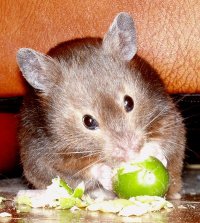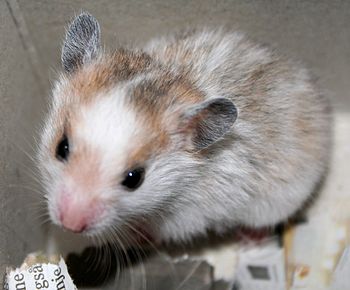 |
| Sable short-haired Syrian Hamster. (Photo credit: Wikipedia) |
Although there are several types of hamsters occurring in the wild, only five are commonly kept as household pets. And though there are several differences between the breeds that make them each unique, there are traits common to all hamsters, regardless of type. Chief among these traits is lifespan - the average hamster has a lifespan of roughly 1000 days, or just a little under three years, with male hamsters living on average just a bit longer than females.
All hamsters have cheek pouches which they use to carry food, or in cases of danger, they're young. Also common among all hamsters is the presence of scent glands, although the location of these glands differs depending on the type of hamster.
All hamsters reach breeding age in roughly 6-8 weeks, with a very short pregnancy lasting only 15 days. The size of the litter averages about 6-8 pups. As you may already know, hamsters are very susceptible to stress, with new mothers being particularly so. If this occurs it's not unusual for the new mother to eat her newborn pups, so it's important to keep stress to an absolute minimum for new hamster mothers.
One of the most common pet hamster breeds, the Syrian hamster is also commonly known as the Teddy Bear hamster, Fancy hamster, and the Golden hamster, among others. Syrian hamsters grow to full size of about 7 inches in length, with the females usually a bit longer than the males.
If you buy a Syrian from the pet store you may see several young Syrian hamsters kept in the same cage - this is very misleading as Syrian hamsters are extremely territorial and will fight to the death with any other hamster they are caged with. The only reason the Syrian hamsters you see in pet stores aren't fighting when you buy them is that they don't develop their territorial nature until about age 6 weeks. After that, the rule is one Syrian hamster per cage!
Here's a story from Tammy Crum, a well-respected hamster breeder:
"A previous partner of mine used a shelving system to store the hamster, with Syrians on top. They were in a fish tank and somehow got out landed in a tank with Roborovskis. Needless to say that by the time he discovered the missing culprit all the Robs were dead."
Given their large size, Syrian hamsters are more easily held for longer periods of time than dwarf hamsters as they tend not to tire as easily. Another interesting fact about Syrian hamsters is that, even though they have the nickname Golden hamster, they come in over 40 different color types. This is achieved through today's advanced breeding techniques, allowing for a range of color and fur length.
Most Syrian hamsters, like all other hamster breeds, do not require any grooming on your part. The only exception to this is the Long Haired Syrian hamster. In this case, a simple toothbrush can be used to remove any bedding material that may be caught up in his fur.
|



